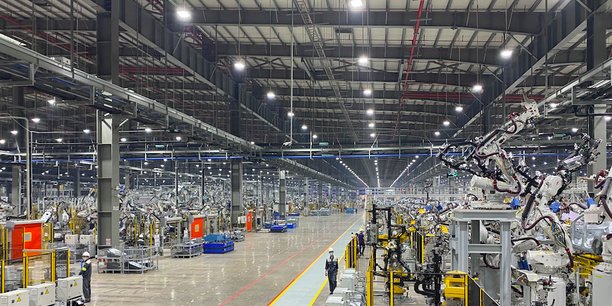
After three years of health crisis, Ha Long Bay had regained its tranquility. Emptied from the 3 million annual visitors, only the fishermen aboard their boats came to disturb the calm and winding waters of this real postcard of Vietnam. As if to anchor its roots in pure local tradition, the powerful conglomerate Vingroup has decided to celebrate the creation of its new automotive business.
Pop atmosphere in Ha Long Bay
But with great amplifications of smoke bombs, sound system, cheerleaders and pop dancers, the atmosphere contrasts with the tranquility of the islets of Ha Long Bay. Vingroup pulled out the heavy artillery to put on a show for an audience of journalists and partners from around the world. Because the group, founded in 1993 in Ukraine by Pham Nhat Vuong, sees it big for its new car daughter that literally started from scratch… Very big in fact! A brand new factory for USD 5 billion near the capital Hanoi, another factory in North Carolina (United States) for USD 2 billion, then a third factory announced in Germany. Vinfast, the car brand that was founded just four years ago, puts considerable resources on the table to establish itself as a world-class car manufacturer. “We wanted to seize an opportunity,” explains the general manager of the group everyone calls Madame Thuy. According to her, the arrival of the electric car has brought down the entry price for this particularly capital-intensive industry. Removing the traction chain makes the car accessible to the average actor.
French in management
But it’s not that simple, especially for a company that has no technical resources. To set up the factories, the industrial processes, the management of the supply chains, the group looked for senior executives almost everywhere. the director of production, Sean Calvert, comes directly from General Motors, as does the head of Design, David Lyon. There are quite a few French in the management of the company, including Franck Euvrard, formerly of Faurecia and in charge of engineering, Emmanuel Bret, who is in sales and marketing, who worked for BMW, or Xavier Kaufman, chief of after-sales and customer experience . Not to mention the express passage of Michael Lohscheller, poached by Opel last summer, to become Vinfast’s new boss… But whose official term did not last five months for personal reasons.
The group also made extensive use of technical subcontractors to set up the processes, most notably Austria’s Magna Steyr. Others intervened as well, such as Siemens. The famous Italian studio Pininfarina was called upon for the design. Finally, the factory in Hanoi bought no fewer than 1,200 robots from ABB, the highly advanced Swedish robot manufacturer.
A blank check?
“They learn very quickly and do not try to impose their own cultural codes, unlike other emerging countries,” explains a newly licentious Western director, who dares not mention China. Vinfast’s other strength is its parent company’s blank check. The account currently stands at well over seven billion dollars. The entire conglomerate is being mobilized to fund this project. Because Vingroup is present in almost all sectors of the Vietnamese economy: hotels, leisure, real estate, finance, electronics… With 45,000 employees, it is the leading group in the country. The creation of Vinfast is motivated by economic reasons as well as by pursuing a genuine national industrial policy.
Even if the market is narrow, Vietnam imports all its new cars. By creating a national champion, Vingroup aims to help reduce the country’s trade balance. It also makes it possible to create a virtuous sector, create jobs and technological added value by attracting equipment manufacturers, and why not one day, other manufacturers. And, of course, it’s also about flattering a certain national chauvinism.
Important capabilities
But to be competitive, Vinfast has to create and sell volume, so it has no choice but to internationalize. And the brand wants to go really fast. The Hanoi facility has a production capacity of 250,000 cars per year, expandable to… 500,000 cars. By comparison, the largest European car factory (with a market of 15 million new cars, compared to 400,000 in Vietnam) runs about 480,000 cars per year. In the United States, the North Carolina facility will produce 150,000 vehicles. We do not yet know the planned capacities in Europe. But Vinfast’s production capacity is already that of an already installed medium-sized manufacturer, while it sold only 40,000 cars last year. In Vietnam, the risk of overcapacity is real, as the site will not produce 100% electric cars until the second half of the year. In addition, Vinfast will be the first manufacturer to start selling electric cars there and thus be responsible for evangelizing the Vietnamese for this technology.
“Vingroup executives work under duress,” an executive from the European subsidiary tries to explain, “that is, they set themselves challenges that force them to move on”. In one year, for example, they have installed no fewer than 40,000 charging stations in the country, compared to 54,000 installed in France in more than five years… The speed of implementation of Vinfast is the great asset of this group.
An IPO in New York
Vinfast therefore invests enormous resources that match its ambitions. However, new resources will have to be found to continue funding. In addition, the group has just announced a plan to list its automotive subsidiary on the New York market. The goal is to raise $2 billion in fresh money. The financial press is calling for a valuation of $60 billion.
But Vinfast risks coming under pressure from the markets if it can’t make money for a few years. Even Tesla took ten years to earn its first dollar.
Especially since Vinfast builds pharaonic factories. Near Hanoi, the Vietnamese group opened the doors of its site to the international press, including La Tribune, who could see the disproportionate size of the site on more than 338 hectares. Where Carlos Tavares has made the densification of production surfaces one of the elements of the competitiveness of its factories, Vinfast has invested in huge surfaces, not to mention the volumes and the heights under ceilings that can protect real buildings, and therefore extremely energy intensive. In addition, the site assembles electric batteries, but also builds electric buses and electric scooters (500,000 per year). And to illustrate the incredible speed of the Vietnamese, this site was built in just 21 months on what was previously a swamp.
Risks of overcapacity
The risk for Vinfast is therefore to end up with overproduction capacity and too high costs. The brand relies on the competitiveness of its products to break through in the market. The planned range includes five models that will cover all market segments (small and large SUVs, compact sedans or city cars). The specifications focus on building premium vehicles (well equipped and well finished) and an innovative after-sales service. All with a competitive price list.
In Europe, the VF8 (a compact SUV) is sold for 43,350 euros, with the rental of batteries for 120 euros per month. Certainly, the autonomy is interesting (420 km according to WLTP standards for the basic version). But the issue of battery rental, invented by the Renault Zoé (in early 2010 but abandoned since) to facilitate the purchase price of the car, could complicate the price readability of the product.
But among Western managers we recognize the agility of the Vietnamese who have no dogma and have only one desire: to succeed. They can adjust and adjust their strategic plan. In Vietnam, Vinfast’s success is not only a matter of jobs, but also includes a pre-eminent dimension of sovereignty and national pride. Some do not hesitate to take revenge on the history of a country that has been in the grip of bloody wars for centuries. A peaceful and electric revenge.


